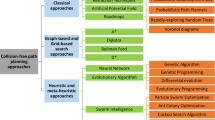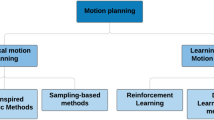Abstract
In this paper, an optimal trajectory generation approach is proposed based on optimal time, optimal jerk and optimal time-jerk by utilizing the interpolation spline methods. The methods including cubic spline, trigonometric spline and a combination of cubic spline and 7th-order polynomial are used for generating the trajectory in joint space for robot manipulators. Cuckoo search (CS) optimization algorithm is chosen to optimize the joint trajectories based on three objectives, namely, minimizing total travelling time, minimizing mean jerk and minimizing a weighted sum of the travelling time and the mean jerk along the whole trajectory. The spline methods have been applied on PUMA-robot for optimizing the joint trajectories with the CS algorithm based on each objective. Moreover, results from the proposed algorithm have been compared with that of the algorithms suggested by earlier studies in terms of three objectives. With the trajectory planning methods, the joint velocities, accelerations and jerks along the whole trajectory optimized by CS meet the requirements of the kinematic constraints in case of each objective. Simulation results validated that the used trajectory planning methods based on the proposed algorithm are very effective in comparison with the same methods based on the algorithms proposed by earlier authors.















Similar content being viewed by others
References
Rubio F, Llopis-Albert C, Valero F, Suñer JL (2016) Industrial robot efficient trajectory generation without collision through the evolution of the optimal trajectory. Robot Auton Syst 86:106–112. https://doi.org/10.1016/j.robot.2016.09.008
Bobrow JE (1988) Optimal robot plant planning using the minimum-time criterion. IEEE J Robot Autom 4(4):443–450. https://doi.org/10.1109/56.811
Bobrow JE, Dubowsky S, Gibson JS (1985) Time-optimal control of robotic manipulators along specified paths. Int J Robot Res 4(3):3–17. https://doi.org/10.1177/027836498500400301
Shin K, McKay N (1985) Minimum-time control of robotic manipulators with geometric path constraints. IEEE Trans Autom Control 30(6):531–541. https://doi.org/10.1109/TAC.1985.1104009
Chen Y, Desrochers AA (1989) Structure of minimum-time control law for robotic manipulators with constrained paths. In: 1989 International conference on robotics and automation (pp. 971–976). IEEE. https://doi.org/10.1109/ROBOT.1989.100107.
Barre PJ, Bearee R, Borne P (2005) Influence of a jerk controlled movement law on the vibratory behaviour of high-dynamics systems. J Intell Robot Syst 42(3):275–293. https://doi.org/10.1007/s10846-004-4002-7
Kyriakopoulos KJ, Saridis GN (1988) Minimum jerk path generation, Robotics and Automation. In: IEEE international conference on robotics and automation (pp. 364–369). IEEE. https://doi.org/10.1109/ROBOT.1988.12075
Mattmüller J, Gisler D (2009) Calculating a near time-optimal jerk-constrained trajectory along a specified smooth path. Int J Adv Manuf Technol 45(9):1007–1016. https://doi.org/10.1007/s00170-009-2032-9
von Stryk O, Schlemmer M (1994) Optimal Control of the Industrial Robot Manutec r3. In: Bulirsch R, Kraft D (eds), Computational optimal control, ISNM international series of numerical mathematics (Vol. 115, pp. 367–382). Basel, Switzerland: Birkhäuser Basel
Hirakawa AR, Kawamura A (1996) Proposal of trajectory generation for redundant manipulators using variational approach applied to minimization of consumed electrical energy. In: Proceedings of 4th IEEE international workshop on advanced motion control—AMC '96—MIE (pp. 687–692). IEEE. https://doi.org/10.1109/AMC.1996.509331
Lin CS, Chang PR, Luh JYS (1983) Formulation and optimization of cubic polynomial joint trajectories for industrial robots. IEEE Trans Autom Control 28(12):1066–1073. https://doi.org/10.1109/TAC.1983.1103181
Aribowo W, Terashima K (2014) Cubic spline trajectory planning and vibration suppression of semiconductor wafer transfer robot arm. Int J Autom Technol 8(2):265–274. https://doi.org/10.20965/ijat.2014.p0265
Gasparetto A, Zanotto V (2008) A technique for time-jerk optimal planning of robot trajectories. Robot Comput-Integr Manuf 24(3):415–426. https://doi.org/10.1016/j.rcim.2007.04.001
Gasparetto A, Zanotto V (2010) Optimal trajectory planning for industrial robots. Adv Eng Softw 41(4):548–556. https://doi.org/10.1016/j.advengsoft.2009.11.001
Liu H, Lai X, Wu W (2013) Time-optimal and jerk-continuous trajectory planning for robot manipulators with kinematic constraints. Robot Comput-Integr Manuf 29(2):309–317. https://doi.org/10.1016/j.rcim.2012.08.002
Chen CS, Chen SK (2019) Synchronization of tool tip trajectory and attitude based on the surface characteristics of workpiece for 6-DOF robot manipulator. Robot Comput-Integr Manuf 59:13–27. https://doi.org/10.1016/j.rcim.2019.01.016
Simon D, Isik C (1991) Optimal trigonometric robot trajectories. Robotica 9(4):379–386. https://doi.org/10.1017/S0263574700000552
Perumaal SS, Jawahar N (2013) Automated trajectory planner of industrial robot for pick-and-place task. Int J Adv Rob Syst 10(2):1–17. https://doi.org/10.5772/53940
Gasparetto A, Zanotto V (2007) A new method for smooth trajectory planning of robot manipulators. Mech Mach Theory 42(4):455–471. https://doi.org/10.1016/j.mechmachtheory.2006.04.002
Liu L, Chen C, Zhao X, Li Y (2016) Smooth trajectory planning for a parallel manipulator with joint friction and jerk constraints. Int J Control Autom Syst 14:1022–1036. https://doi.org/10.1007/s12555-014-0495-4
Boryga M, Graboś A (2009) Planning of manipulator motion trajectory with higher-degree polynomials use. Mech Mach Theory 44(7):1400–1419. https://doi.org/10.1016/j.mechmachtheory.2008.11.003
Machmudah A, Parman S, Zainuddin A, Chacko S (2013) Polynomial joint angle arm robot motion planning in complex geometrical obstacles. Appl Soft Comput 13(2):1099–1109. https://doi.org/10.1016/j.asoc.2012.09.025
Huang J, Hu P, Wu K, Zeng M (2018) Optimal time-jerk trajectory planning for industrial robots. Mech Mach Theory 121:530–544. https://doi.org/10.1016/j.mechmachtheory.2017.11.006
Wang M, Luo J, Yuan J, Walter U (2018) Coordinated trajectory planning of dual-arm space robot using constrained particle swarm optimization. Acta Astronaut 146:259–272. https://doi.org/10.1016/j.actaastro.2018.03.012
Kucuk S (2018) Optimal trajectory generation algorithm for serial and parallel manipulators. Robot Comput-Integr Manuf 48:219–232. https://doi.org/10.1016/j.rcim.2017.04.006
Lu S, Zhao J, Jiang L, Liu H (2017) Time-jerk optimal trajectory planning of a 7-DOF redundant robot. Turk J Electr Eng Comput Sci 25:4211–4222. https://doi.org/10.3906/elk-1612-203
Rout A, Dileep M, Mohanta GB, Deepak B, Biswal B (2018) Optimal time-jerk trajectory planning of 6 axis welding robot using TLBO method. Procedia Comput Sci 133:537–544. https://doi.org/10.1016/j.procs.2018.07.067
Savsani P, Jhala RL, Savsani VJ (2013) Optimized trajectory planning of a robotic arm using teaching learning based optimization (TLBO) and artificial bee colony (ABC) optimization techniques. In: 2013 IEEE ınternational systems conference (SysCon). https://doi.org/10.1109/syscon.2013.6549910
Savsani P, Jhala RL, Savsani VJ (2016) Comparative study of different metaheuristics for the trajectory planning of a robotic arm. IEEE Syst J 10(2):697–708. https://doi.org/10.1109/jsyst.2014.2342292
Wang M, Luo J, Fang J, Yuan J (2018) Optimal trajectory planning of free-floating space manipulator using differential evolution algorithm. Adv Space Res 61(6):1525–1536. https://doi.org/10.1016/j.asr.2018.01.011
Bureerat S, Pholdee N, Radpukdee T, Jaroenapibal P (2019) Self-adaptive MRPBIL-DE for 6D robot multiobjective trajectory planning. Expert Syst Appl 136:133–144. https://doi.org/10.1016/j.eswa.2019.06.033
Kolter JZ, Andrew YN (2009. Task-space trajectories via cubic spline optimization. In: IEEE international conference on robotics and automation (pp. 1675–82). IEEE. https://doi.org/10.1109/ROBOT.2009.5152554
Kucuk S (2016) Maximal dexterous trajectory generation and cubic spline optimization for fully planar parallel manipulators. Comput Electr Eng 56:634–647. https://doi.org/10.1016/j.compeleceng.2016.07.012
Schoenberg IJ (1964) On trigonometric spline interpolation. J Math Mech 13(5):795–825
Koch PE (1984) Error bounds for interpolation by fourth order trigonometric splines. In: Singh SP, Burry JWH, Watson B (eds) Approximation theory and spline functions, vol 136. Springer, Dordrecht, pp 349–360
Lyche T, Winther R (1979) A stable recurrence relation for trigonometric B-splines. J Approx Theory 25(3):266–279. https://doi.org/10.1016/0021-9045(79)90017-0
Kennedy J, Eberhart RC (1995) Particle swarm optimization. In: Proceedings of ICNN'95—international conference on neural networks, pp1942–1948. IEEE. https://doi.org/10.1109/ICNN.1995.488968
Yang XS, Deb S (2009) Cuckoo search via Levy flights. In: 2009 World congress on nature & biologically inspired computing (NaBIC), pp 210–214. IEEE. https://doi.org/10.1109/NABIC.2009.5393690
Soneji H, Sanghvi RC (2012) Towards the improvement of Cuckoo search algorithm. In: World Congress on Information and Communication Technologies (WICT), 2012, pp 878–883. IEEE
Yang XS, Deb S (2010) Engineering optimisation by cuckoo search. Int J Math Modell Numer Optim 1(4):330–343
Buskens C, Maurer H (2000) SQP methods for solving optimal control problems with control and state constraints: adjoint variables, sensitivity analysis and real time control. J Comput Appl Math 120(1–2):85–108. https://doi.org/10.1016/S0377-0427(00)00305-8
Azarfar A, Azarfar B, Vahedi M (2021) Self-tuning fuzzy task space controller for puma 560 robot. J Electr Eng Technol 16:579–589. https://doi.org/10.1007/s42835-020-00576-6
Author information
Authors and Affiliations
Corresponding author
Additional information
Publisher's Note
Springer Nature remains neutral with regard to jurisdictional claims in published maps and institutional affiliations.
Rights and permissions
Springer Nature or its licensor holds exclusive rights to this article under a publishing agreement with the author(s) or other rightsholder(s); author self-archiving of the accepted manuscript version of this article is solely governed by the terms of such publishing agreement and applicable law.
About this article
Cite this article
Karahan, O., Karci, H. & Tangel, A. Optimal trajectory generation in joint space for 6R industrial serial robots using cuckoo search algorithm. Intel Serv Robotics 15, 627–648 (2022). https://doi.org/10.1007/s11370-022-00440-8
Received:
Accepted:
Published:
Issue Date:
DOI: https://doi.org/10.1007/s11370-022-00440-8




